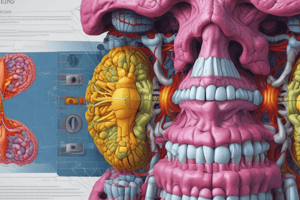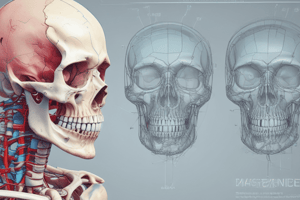Podcast
Questions and Answers
What is the main focus of the content related to computed tomography equipment techniques?
What is the main focus of the content related to computed tomography equipment techniques?
- Radiation exposure levels
- Patient safety protocols
- Calibration of imaging devices
- Interpolation algorithms and pitch (correct)
Which department at Al Ain University is associated with the mentioned content?
Which department at Al Ain University is associated with the mentioned content?
- Department of Emergency Services
- Department of Radiology and Sonography (correct)
- Department of Health Administration
- Department of Biomedical Engineering
In the context of computed tomography, what might be a key application of interpolation algorithms?
In the context of computed tomography, what might be a key application of interpolation algorithms?
- Shortening examination times
- Increasing radiation dosage
- Reducing patient discomfort
- Enhancing image resolution (correct)
What is likely the significance of pitch in computed tomography?
What is likely the significance of pitch in computed tomography?
Which of the following accurately describes interpolation in imaging techniques?
Which of the following accurately describes interpolation in imaging techniques?
What is the primary function of an interpolation algorithm?
What is the primary function of an interpolation algorithm?
In what context is data interpolation typically required?
In what context is data interpolation typically required?
Which statement correctly describes the nature of data interpolation?
Which statement correctly describes the nature of data interpolation?
Which of the following best defines interpolation in data analysis?
Which of the following best defines interpolation in data analysis?
Which computer program is designed to perform data interpolation?
Which computer program is designed to perform data interpolation?
What is the primary purpose of image interpolation in medical imaging?
What is the primary purpose of image interpolation in medical imaging?
What issue arises from continuous tube and table motion during imaging?
What issue arises from continuous tube and table motion during imaging?
How does isotropic volume imaging enhance image quality?
How does isotropic volume imaging enhance image quality?
What is a consequence of a helical motion in imaging?
What is a consequence of a helical motion in imaging?
What does the term 'slices' refer to in the context of image interpolation?
What does the term 'slices' refer to in the context of image interpolation?
What is a characteristic of helical CT scanning data acquisition?
What is a characteristic of helical CT scanning data acquisition?
Why can't conventional reconstruction algorithms be applied to helical CT scanning data?
Why can't conventional reconstruction algorithms be applied to helical CT scanning data?
What type of trajectory does the x-ray source follow in helical CT scanning?
What type of trajectory does the x-ray source follow in helical CT scanning?
Which statement is NOT true regarding helical CT scanning?
Which statement is NOT true regarding helical CT scanning?
The helical path in CT scanning helps to achieve which advantage?
The helical path in CT scanning helps to achieve which advantage?
What does interpolation primarily involve?
What does interpolation primarily involve?
What role do weighting factors play in interpolation?
What role do weighting factors play in interpolation?
Which statement best describes the reconstruction plane in interpolation?
Which statement best describes the reconstruction plane in interpolation?
What happens to the projection angles in the interpolation process?
What happens to the projection angles in the interpolation process?
Which of the following best summarizes the concept of interpolation?
Which of the following best summarizes the concept of interpolation?
What is the primary difference between traditional CT scans and volume imaging CT?
What is the primary difference between traditional CT scans and volume imaging CT?
Which imaging method is capable of creating 3D reconstructions?
Which imaging method is capable of creating 3D reconstructions?
What type of images do traditional CT scans produce?
What type of images do traditional CT scans produce?
What advantage does volume imaging CT have over traditional CT scans?
What advantage does volume imaging CT have over traditional CT scans?
Why is volume imaging CT considered superior in certain situations?
Why is volume imaging CT considered superior in certain situations?
Flashcards
Interpolation
Interpolation
The process of estimating the value of a missing data point based on existing data points.
Interpolation Algorithm
Interpolation Algorithm
A computer program that uses interpolation methods to estimate missing data points.
Existing Data Points
Existing Data Points
Data that is used to estimate missing data points.
Estimated Value
Estimated Value
Signup and view all the flashcards
Missing Data Point
Missing Data Point
Signup and view all the flashcards
Computed Tomography (CT)
Computed Tomography (CT)
Signup and view all the flashcards
Pitch
Pitch
Signup and view all the flashcards
High Pitch
High Pitch
Signup and view all the flashcards
Low Pitch
Low Pitch
Signup and view all the flashcards
Image Interpolation
Image Interpolation
Signup and view all the flashcards
Isotropic Volume Image
Isotropic Volume Image
Signup and view all the flashcards
Helical Motion
Helical Motion
Signup and view all the flashcards
Image Reconstruction
Image Reconstruction
Signup and view all the flashcards
Continuous Tube and Table Motion
Continuous Tube and Table Motion
Signup and view all the flashcards
Helical CT Scanning
Helical CT Scanning
Signup and view all the flashcards
Helical Data Set
Helical Data Set
Signup and view all the flashcards
Conventional Reconstruction Limitations
Conventional Reconstruction Limitations
Signup and view all the flashcards
Pitch in CT Scan
Pitch in CT Scan
Signup and view all the flashcards
Pitch and Image Quality
Pitch and Image Quality
Signup and view all the flashcards
Interpolation in CT
Interpolation in CT
Signup and view all the flashcards
Weighting Factors in Interpolation
Weighting Factors in Interpolation
Signup and view all the flashcards
Weighted Average in Interpolation
Weighted Average in Interpolation
Signup and view all the flashcards
Different Weighting Factors for Each Projection Angle
Different Weighting Factors for Each Projection Angle
Signup and view all the flashcards
Projection Angles in CT Reconstruction
Projection Angles in CT Reconstruction
Signup and view all the flashcards
Volume Imaging CT
Volume Imaging CT
Signup and view all the flashcards
3D Reconstruction
3D Reconstruction
Signup and view all the flashcards
Traditional CT
Traditional CT
Signup and view all the flashcards
Difference between Traditional CT and Volume Imaging CT
Difference between Traditional CT and Volume Imaging CT
Signup and view all the flashcards
Advantages of Volume Imaging CT
Advantages of Volume Imaging CT
Signup and view all the flashcards
Study Notes
Computed Tomography Equipment Techniques
- Computed Tomography (CT) uses interpolation algorithms to reconstruct images.
- Interpolation estimates values between known data points.
- Extrapolation estimates values beyond known data points.
- During helical CT, data is acquired continuously.
- Interpolation creates new slices between existing ones to obtain an isotropic volume image.
- Helical CT's distinctive movement creates unique reconstruction challenges.
- Conventional methods struggle with the helical trajectory.
- Interpolation algorithms allow reconstructed images to represent the helical scan's data. The data can then be transformed from helical to planar datasets.
- Pitch is a crucial helical CT parameter.
- It's defined as the ratio of table travel per 360° rotation to the beam width.
- Pitch = table travel / beam width
- Pitch values relate to data acquisition.
- Pitch equals 1: Data is contiguous.
- Pitch less than 1:Data overlaps.
- Pitch greater than 1: Data is separated.
- Volume imaging in CT allows data acquisition from a larger volume, enabling 3D representations.
- Traditional CT creates 2D images.
- Volume imaging creates a more comprehensive understanding of the scanned region.
- Volume imaging and pitch are related.
- Tissue imaged = beam width × pitch × imaging time / gantry rotation time
Helical CT Scanner Advantages
- Fast scan times provide large data collections.
- Minimizes motion artifacts.
- Less mis-registration between consecutive slices.
- Reduced patient radiation dose.
- Enhanced spatial resolution.
- Enables advanced multiplanar or 3D renderings.
- Improved temporal resolution.
Studying That Suits You
Use AI to generate personalized quizzes and flashcards to suit your learning preferences.




